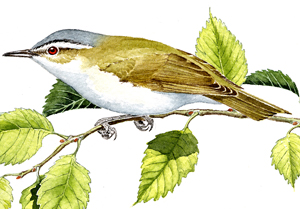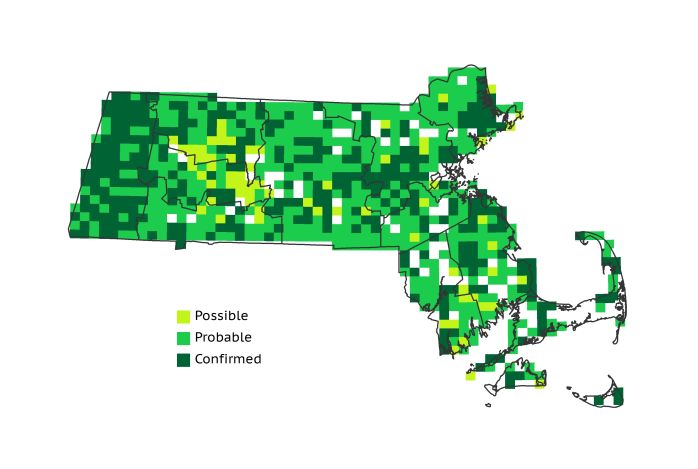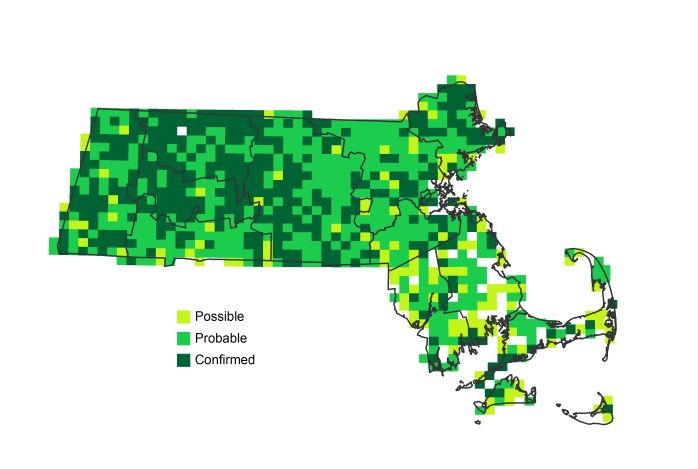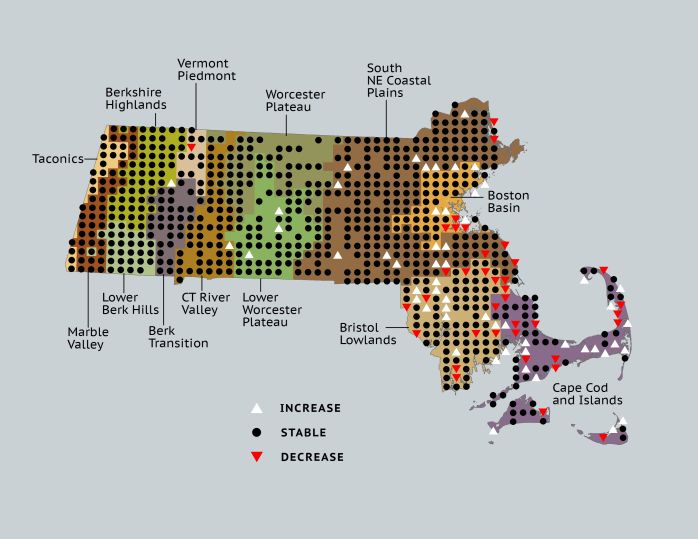Find a Bird
Red-eyed Vireo
Vireo olivaceus

Nearly ubiquitous and stable
“The darker the woods, the more cloudy the day, the more unremitting are its exertions.” – John James Audubon, Birds of America
The Red-eyed Vireo is the most common breeding vireo in Massachusetts, and during the breeding season it can be heard singing from the Berkshires to Nantucket. Red-eyed Vireos sing almost nonstop from sunrise to sunset throughout the spring and summer. Their song is the most oft-heard of all the vireo species, so learning to recognize it should be an early priority for any birder in this area. Fortunately, Red-eyed Vireos are not difficult to find in most regions of the state during the breeding season.
Historic Status
Red-eyed Vireos have long defied conventional logic, often singing from their nest throughout the day, seemingly unwary of would-be nest predators. Dubbed “the Preacher” by author Wilson Flagg for its never-ending song (Flagg 1890), which, according to one writer, made the bird either “excessively stupid or excessively kind” (Blanchan 1897), the Red-eyed Vireo has adapted well to historic habitat changes that have challenged many other species. Deciduous forests were altered markedly during the seventeenth, eighteenth, and nineteenth centuries in Massachusetts, yet the species “became common wherever trees grow, even in cities,” according to Edward Howe Forbush. During his childhood, Forbush saw Red-eyed Vireos as common birds of the streets of Boston. The midnineteenth century introduction of House Sparrows, however, caused problems for Red-eyed Vireos in the cities, gradually forcing them back to their more natural environs (Forbush 1929).
Atlas 1 Distribution
During Atlas 1, Red-eyed Vireos were widespread. The second-growth forests with small gaps that dominated the western part of the state suited Red-eyed Vireos quite well, and many western regions had 100% block occupancy or near enough in the 1970s. The hedgerows and farmsteads of the Connecticut River Valley were no less suitable for these adaptable birds, and the Worcester Plateau also had Red-eyed Vireos aplenty, with no region reporting less than 95%. The rapidly developing Coastal Plains had a few small gaps in their distribution, and the small area of the Boston Basin around the city of Boston itself had no vireos to speak of. The Bristol/Narragansett Lowlands had a comparatively low block occupancy rate at 81%, while the Cape and Islands was the only ecoregion to have less than 50% occupancy by this otherwise ubiquitous species.
Atlas 2 Distribution and Change
By the time of Atlas 2, a single unoccupied block in the Vermont Piedmont region was virtually the only thing keeping Red-eyed Vireos from being found literally everywhere west of the Coastal Plains. The Coastal Plains reported a small gain of Red-eyed Vireos to outweigh the few blocks from which the species disappeared during the intervening 30 years. The Boston Basin had a similar balance of gains and losses, and the dozen or so blocks gained and lost in the Bristol/Narragansett Lowlands suggest only a minor degree of “shuffling” of the population during the inter-Atlas period. The Cape and Islands passed the 50% occupancy mark during this period, though the region still hosted the fewest Red-eyed Vireo records in the state by far.
Atlas 1 Map

Atlas 2 Map

Atlas Change Map

Ecoregion Data
Atlas 1 | Atlas 2 | Change | ||||||
Ecoregion | # Blocks | % Blocks | % of Range | # Blocks | % Blocks | % of Range | Change in # Blocks | Change in % Blocks |
Taconic Mountains | 16 | 100.0 | 2.0 | 25 | 100.0 | 2.8 | 0 | 0.0 |
Marble Valleys/Housatonic Valley | 39 | 100.0 | 4.8 | 39 | 100.0 | 4.3 | 0 | 0.0 |
Berkshire Highlands | 54 | 98.2 | 6.6 | 55 | 100.0 | 6.1 | 1 | 1.9 |
Lower Berkshire Hills | 28 | 100.0 | 3.4 | 31 | 100.0 | 3.4 | 0 | 0.0 |
Vermont Piedmont | 17 | 100.0 | 2.1 | 16 | 94.1 | 1.8 | -1 | -8.3 |
Berkshire Transition | 36 | 94.7 | 4.4 | 40 | 100.0 | 4.4 | 0 | 0.0 |
Connecticut River Valley | 54 | 96.4 | 6.6 | 59 | 90.8 | 6.5 | 1 | 2.1 |
Worcester Plateau | 75 | 96.2 | 9.2 | 87 | 98.9 | 9.6 | 0 | 0.0 |
Lower Worcester Plateau | 65 | 87.8 | 8.0 | 80 | 100.0 | 8.8 | 3 | 5.6 |
S. New England Coastal Plains and Hills | 242 | 89.6 | 29.6 | 265 | 93.6 | 29.2 | 6 | 2.7 |
Boston Basin | 40 | 71.4 | 4.9 | 43 | 76.8 | 4.7 | 3 | 5.5 |
Bristol and Narragansett Lowlands | 86 | 81.1 | 10.5 | 90 | 78.9 | 9.9 | 2 | 2.0 |
Cape Cod and Islands | 65 | 47.8 | 8.0 | 77 | 53.5 | 8.5 | 4 | 3.3 |
Statewide Total | 817 | 84.3 | 100.0 | 907 | 87.5 | 100.0 | 19 | 2.3 |
Notes
Interestingly, the Red-eyed Vireo shows no significant Breeding Bird Survey (BBS) trend in Massachusetts, a significant decreasing BBS trend in the New England/Mid-Atlantic Region, and a significant increasing BBS trend in the Eastern US overall.



